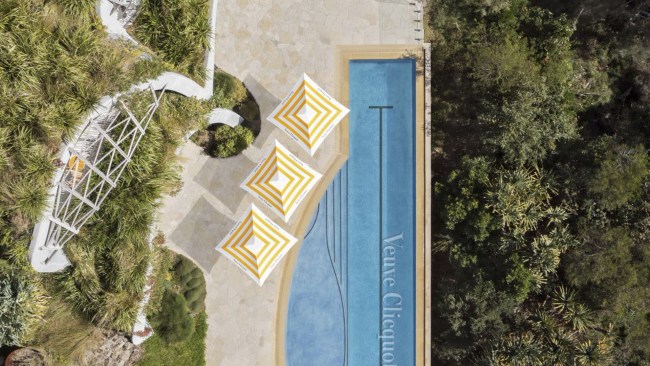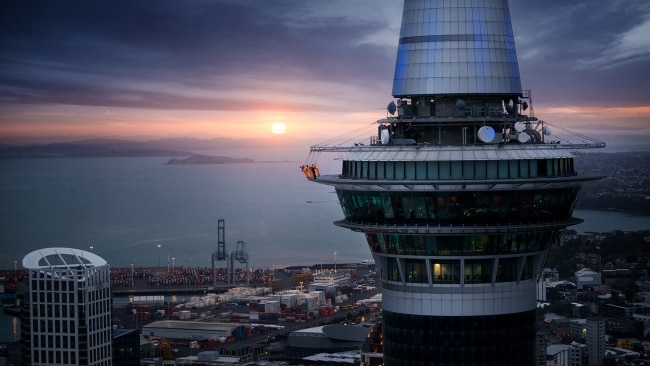Into the Karoo
THE Great Karoo is mysterious and dramatic, ancient beyond reckoning.
THERE are big-rumped zebras hanging out and black wildebeests mooching about before they take off in a flurry of dust, as if they've just remembered a pressing engagement.
Herd animals are supposed to roam the expansive grasslands of South Africa but on this vast Kandoa Plateau, which feels like an inverted cake tin, the beasts all but have their heads in the clouds and our perimeter is a raggedy old edge that plunges to the Plains of Camdeboo.
GALLERY: Susan Kurosawa's best four South African game park lodges
From up here, we look at great swaths of land where millions of migrating springbok once kicked up so much dust that the air hung heavy with haze for a week. On a very clear day we are told we could see the coastline; what we can spot now are the encircling peaks of hard old mountains and wide-winged birds gliding on warm thermals. The light shifts, dips into the folds and furrows of the rocky landscape. It is mysterious and dramatic, ancient beyond reckoning.
GAME FOR ANYTHING Susan Kurosawa presents her pick of South Africa's top safari lodges Royal Legend Safari Lodge & Spa, Timbavati Game Reserve: In a tiny corner of the flat and thorny 60,000ha Timbavati Game Reserve near the Kruger National Park, this lovely camp has just 10 chalets with thatched roofs and bags of bush-chic style. www.legendlodges.co.za. Royal Malewane, Greater Kruger National Park: All the exclusive suites come with a private bush-fringed pool at Sir Elton John's lodge of choice. New to the property is the Africa House, a self-contained villa that is the safari house-party dream writ true. www.royalmalewane.com. Elephant House, Eastern Cape: A nine-room lodge on the perimeter of the Addo Elephant National Park, a reserve that has been a resounding conservation success as a sanctuary for jumbos. This smart farmhouse-style hide-out is the perfect venue at which to toast the wild. www.elephanthouse.co.za. Londolozi, Sabi Sand Private Reserve: A time-tested favourite to the west of the Kruger, this famous lodge has all the right eco-credentials and is prime leopard-viewing territory; creature comforts come in a variety of accommodation styles, including treehouses. Splash out on one of the three Private Granite Suites with private heated pools. www.londolozi.com.
We are atop an elevated reach of the Samara reserve in the Great Karoo region of South Africa's eastern cape. With 28,000ha of indigenous vegetation, encompassing four of South Africa's seven biomes, it's one of the country's largest private game reserves and, in conservation terms, it has proved a groundbreaking success since a campaign of land rejuvenation was started in 1997.
Eleven farms have been purchased across this territory and fences removed. Game animals that populated the savanna and hills before the 19th-century settlers farmed the heck out of it have been gradually reintroduced. This is angora wool country and the grazing of goats, plus intrusions of cattle and sheep, had caused erosion and degradation of land and vegetation. Small-scale safari tourism is the way forward, with the attractive marketing lure that the Great Karoo is malaria-free territory and a short flight from Cape Town and its famous winelands and beaches.
Our ranger Wayne is a bush bloke through and through, and always ready to spar with us about cricket and, most of all, rugby and the respective merits of the Springboks and the Wallabies, not that he can find much that's worthy of praise in the latter team. He takes a while to warm up but when he does he is enormous fun and takes our endless gibes with good grace.
As the sun begins to fade over the Kondoa Plateau and the sharp cold air of early evening creeps through our khaki clobber, Wayne stops our canopied Landcruiser and sets up his portable wet bar on an ingenious table flap that folds down from the vehicle's bonnet. We hop down and sip icy G&Ts from metal beakers and eat crisps, nuts and chewy strips of biltong from a tiffin carrier. By the end of our first day in the Great Karoo, he is learning Aussie slang and answering to Wayne-o.
Samara's five-star base camp is a colonial-style homestead beneath the escarpment of the southern flank of the Sneeuberg mountain range. Sneeuberg means snow mountain but a map of the reserve reveals such unambiguous names as Vulture Mountain, Monkey River, Eagle Rock, Cheetah Pan and Dead Tree Dam. It is a chart full of promise.
The main lodge has deep wraparound verandas that provide shade and covered spaces for squashy sofas and colonial planter chairs. There is no mobile phone reception and the spare, almost desolate landscape begs to be called remote. But we are three hours by road from Port Elizabeth and there's nothing desolate about thefacilities.
There are three lodge suites in the main building and three Karoo suites, which are spacious freestanding cottages surrounded by buffalo grass and acacias and dotted close to the lodge, but not so close that you can get by without calling a ranger to walk you to and fro at night. There are two evil-looking cape buffaloes eyeing me off on the first evening, although my escort, one of the front-desk team, insists they are just "glorified cows". The familiar safari design vocabulary is in play through the public areas and guest suites, from zebra skins on the floors and antelope skulls on the walls to displays of porcupine quills and old fruit-picking baskets. It's the 21st-century interpretation of pioneering style, minus any privations.
In the suites, there are bamboo-lined ceilings, open fires, chunky stinkwood and yellow wood furniture (including four-poster beds), framed lithographs of birds and botanicals and country-house fabrics, including a toile de jouy that, on closer inspection, turns out not to feature picnicking French aristocrats but ostriches, parrots and monkeys at play. And the real monkeys -- naughty little vervets with black-button eyes -- are right outside, peering through the french doors, eyeing off the fruit basket.
A decanter of sherry and a drawn bubble bath awaits after each day's late-afternoon game drive so you can muster your resources for the cocktail hour and convivial evening meal with a maximum of 11 fellow guests. If anyone looks the slightest bit faint, someone's arm will appear attached to a tray and, like a conjurer's trick, there'll be pressed on you a reviving hot chocolate with a good dash of Amarula Cream liqueur.
The service and the feeling of bonhomie at Samara are first class. Even the afternoon tea that's laid on before the second game drive of each day is a thundering spread of savoury crepes, little quiches, pear and apple tarts and carrot cake. And it's only been two hours since lunch.
Safari here is not all about animal sightings but nonetheless our spotters' checklists fill up nicely and we are well rewarded with even-toed ungulates ("the horny guys", says Wayne-o), from curly-horned kudu, oryx and eland to blesbuck and mountain reedbuck. It's the wow-factor of the landscape -- high valleys, plateaus, savanna, ranges of mountains with molar-like peaks -- and the variety of vegetation that endlessly enthrals.
The shepherd's trees, with their white trunks and twisted branches, speckle the bush like so many signposts; the spekbos bush has small fatty leaves and the bitter sap of the mountain aloe, Wayne-o advises, is the perfect application to stop fingernail biting.
The splendidly named Karoo num num berry is rich in vitamin C and calcium, we learn, and the equally fantastically named spekboom bush is a favourite of black rhino browsers; it grows in thickets at the bottom of a kopje (or small hill) that we drive up at a near-perpendicular angle with Wayne-o grunting at the wheel and our hearts in our mouths.
The landscape may be harsh but the colours are soft; the bush presents irrefutable evidence of the inadequacy of that word green. In the Great Karoo, there is a paint-chart that changes by degrees from the paleness of bearded lichen and the ashy grey-green of the camphor bush to the dark gloss of berry-bearing bushes.
During a candlelit dinner one night in the polished dining room -- butternut pumpkin soup, tender Karoo lamb fragrant with wild rosemary, old-fashioned baked pudding and custard -- there is the unlikely call of something like "rhinos are up". We push back our chairs and off we bash in Wayne-o's vehicle for less than a minute to see two white rhinos pottering about the lodge's front lawn as casually as a couple of pets. But without a torch they just loom like bushes and I can't help thinking I could have walked straight into them if they'd chosen the grass around my little Karoo cottage for their eveningsoiree.
We all want to see Sibella, Samara's resident matriarch cheetah who was released from captivity and then a rehabilitation centre to Samara in 2003. Relocated with two males, she is one of the first cheetahs to be returned to the Great Karoo in more than a century; her forebears had been hunted to near extinction. She's had 18 cubs in three litters and the guestbook is full of fond recollections of Sibella encounters, including one guest who apparently found her on their cottage veranda one morning. How boastful. We don't see even a whisker.
But we can't complain about the bush bounty revealed during Wayne-o's drives. My spotter's checklist reveals red hartebeest with their heart-shaped horns, guineafowl (never eat them in a month with the letter R, Wayne-o says, somewhat enigmatically), bustard kori (the world's heaviest bird) and, on our first night drive, scampering scrub hares, a spotted eagle owl and a cartoon-cute bat-eared fox. Samara has more than 180 species of birds: next time, Wayne-o, if for nothing but dinner-party one-upmanship, I want to see a common titbabbler, a lesser swamp warbler, a fork-tailed drongo and, please, a spotted thick-knee.
The conservation mantra from Samara's owners, Mark and Sarah Tompkins, more or less comes down to the fact we don't inherit the land from our fathers but we borrow it from our children. It's an uplifting message and one we carry with us as we set off for Port Elizabeth and beyond as Wayne-o waves goodbye and we desperately scan every bush and tree for a last-chance sighting of the elusive Sibella.
Susan Kurosawa was a guest of South African Tourism.
Checklist
Samara is 254km from Port Elizabeth; transfers are available, or arrive by rental car (most of the road is tarred but there's a gravel track of about 20km). There are daily flights to Port Elizabeth from Johannesburg, Durban and Cape Town.
Depending on the season, rates start from 1550rand ($240) to 3600 rand a person a night twin-share; the rate includes meals and two game drives daily with an expert ranger. Valid for the month of September is a "stay three nights and pay for two" offer to celebrate the opening of the Samara Spa, which overlooks a dam with an abundance of waterbirds. The deal also includes a complimentary massage for each guest. More: www.samara.co.za.
www.southafrica.net



